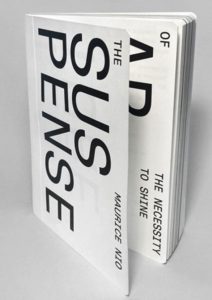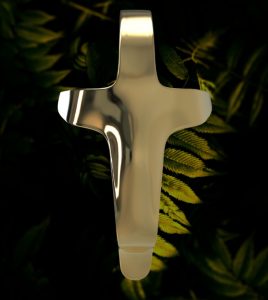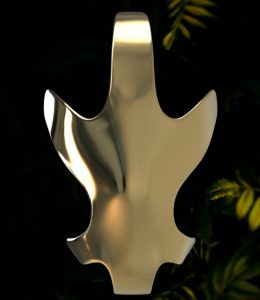 Maurice Nio (1959), Dutch architect theorist, writer and artist passed away on July, 11, 2023. Last Friday night I attended the launch for his new book The Suspence of Architecture-The Necessity to Shine (published by Thousand and One Publishers in Amsterdam, order here). Maurice was still able to finish the manuscript. Many colleagues, friends and family and staff of his continuing NIO architecture office, gathered in Rottterdam to celebrate the life and work of this extraordinary and singular thinker and maker. The Zerp Gallery, where the event took place, exhibited his golden masks and three holograms with Latin quotes from Spinoza’s Ethics–in a typeface designed by Maurice himself.
Maurice Nio (1959), Dutch architect theorist, writer and artist passed away on July, 11, 2023. Last Friday night I attended the launch for his new book The Suspence of Architecture-The Necessity to Shine (published by Thousand and One Publishers in Amsterdam, order here). Maurice was still able to finish the manuscript. Many colleagues, friends and family and staff of his continuing NIO architecture office, gathered in Rottterdam to celebrate the life and work of this extraordinary and singular thinker and maker. The Zerp Gallery, where the event took place, exhibited his golden masks and three holograms with Latin quotes from Spinoza’s Ethics–in a typeface designed by Maurice himself.
I (1959) got to know Maurice Nio around 1987 when I got to know many of the members of the Delft architecture theory scene, a world class circle of imaginary thinkers in a country dominated by pragmatism and anti-intellectualism. Why would an engineering polytech create such one-off thinkers and not philosophy departments, I always wondered. As a media theory misfit I was welcomed in this circle and in the decade after often stumbled into Maurice and his friend Lars Spuybroek (1959), who, together, in the roaring 1990s, edited the NOX journal. In 1988 I made an interview for my Bilwet Portrettengallerij program at Radio 100 with Maurice about his TH Delft graduation design: a villa for Michael Jackson. The digitization of the audio cassettes didn’t quite work out but here it is, in Dutch.
In 1985, together with Kees Vollemans, Maurice Nio translated Jean Baudrillard’s Fatal Strategies into Dutch. This was his defining moment that shaped both his writing style, vocabulary and artistic practice. Jean Baudrillard died in 2007, also of cancer. Needless to say, Baudrillard did not found a school with followers. Rather a loner, he did not aspire to become a master surrounded by a swarm of pupils. Nonetheless, there is small but distinct group of admirers that continue to work in his direction. I count myself as one of them, but the influence of Baudrillard on Maurice Nio is no doubt stronger and directly visible, also in his architecture (perhaps comparable to Achim Szepanski, see his latest book In the Delirium of the Simulation).
The question who remains close to the ‘teachings’ of master Baudrillard still remains a sensitive one. If you are fond of ‘dense theory’ that opens unheard conceptual spaces, please join me and others and read Maurice Nio’s musing on the ‘necessity to shine’. There are ‘sectarian tendencies’ but on an all together different magnitude (and mostly on the level of the all-too-human ‘social noise’). In this case it not the Bible or Das Kapital but poetry as such. Not a bad situation to be in. Look how Maurice’s golden masks are shining. And look how he found an eager audience for his work in Italy. But now, from Atlanta, Georgia, where he’s architecture professor at Georgia Tech–here is Lars Spuybroek, connected via Zoom, who read the following text during the book launch:
—
Unseen, Architecture Slipped Away
Lars Spuybroek, for Maurice (March 15, 2024)
I’ll start with a statement: architecture can only be inhabited, art can only be visit–ed. Sure, you can “visit” architecture, but that’s deceptive, leading to an error that many architects, architecture students, architecture critics and clients make. What you see when you visit architecture is something completely different from what you see when you inhabit it. Quite the opposite, in fact, because it’s in the nature of architecture to disappear. Let me give you an example from experience:
I once “visited” one of the most beautiful, and, by the way, one of the most critically neglected churches in Holland, a hidden neogothic gem, completely covered on the inside with polychrome patterns. (Just so you know, I am speaking of the Sint Willibrordkerk in Utrecht.) When I was there, looking around with my head raised in awe, I could not believe my eyes: I saw what I would call the continuous breaking of light, not just the spectrum of the stained glass windows, but the kaleidoscopic breaking of all elements into a myriad of color patterns. Green with white lilies and golden diagonals, purple with blue acanthus leaves, white with olive green chevrons, green with red crosses: it was like a scholastic exercise, everything was constantly being subdivided; not even the color itself could remain whole. It was like seeing an architecture that testified to cosmic noise and entropy: as things come together they also fall apart.
“A place that cries out to be seen,” I said to myself, “architecture could hardly appeal more to the eyes.” This proved to be my fundamental mistake.
Inside this church, there were a dozen or so parishioners, deep in prayer, on their knees, hands clasped together, eyes tightly shut. Watching these unseeing “inhabitants” it suddenly dawned on me how right they were: the polychrome interior was not crying out to be seen, but to be tapped into. They were tapping into the murmur and noise of the color patterns, as if tuning in on all radio frequencies at once. As they say in physics, the Cosmic Background Noise of the Big Bang can still be heard—by the way, “cosmic” and “cosmetic” mean exactly the same thing. What I witnessed was nothing less than the absolute power of architecture: to disappear in plain sight. Decorate your room with the noisiest wallpaper, then eat your breakfast there every day, and it takes no more than a week for the wallpaper to become unseen, to turn into a murmur. To turn into a background noise that we silently tap into, that keeps us moving and lifts us up to carry us where needed.
We cannot really visit architecture then. The verb “to visit” comes from videre, “to see”. Of course, you can go, do some sight-seeing, make notes, take photos, be critical, but architecture itself is absolutely uncritical. It resists vision, you don’t really understand it by looking at it, you have to live with it, inhabit it. To paraphrase Maurice: “Unseen, architecture slips away.” Architecture is an art of the unseen.
Speaking of art, let’s separate the two for a moment: Architecture deals with the unseen, art with the seen. Where architecture hides, art shines. Yet, it’s architecture as such that hides, because we do see something, quite a lot actually. While architecture withdraws and communicates with the cosmic background, things move to the foreground. In fact, architecture seems to stage things, to give them a frame. In this sense, we should say: “Architecture makes things appear,” that is, “shine”, as in the German Erscheinen or the Dutch verschijnen.
The statement then becomes: “Architecture makes things shine by disappearing,” by going opaque, by diving under the radar of consciousness. This is (a) why architecture is not art, and (b) why art is totally dependent on architecture; it stands on the floor, hangs on the wall. Art stands out, comes to the fore. It does the exact opposite of architecture: art shines and makes things disappear by making them mysterious and enigmatic. Maurice emphasized this over and over again: things need to be mysterious and enigmatic. So for art and architecture, what they are and what they show are opposites, but complementary opposites: supervisibly art veils and masks, invisibly architecture makes things appear. That’s Maurice’s Loop, the loop he loved to spin around in like a whirling dervish.
Neither architecture nor art is interested in simply claiming one of the poles of the unseen or the seen. They both claim the switching of the poles: architecture from the unseeing to the shining, art from the shining to the hidden. And together they form a loop, or rather an exchange. What one hides is what the other shows, and vice versa; they hand things over to each other.
Maurice’s wonderful video, made with a drone flying over a wild and inaccessible forest floor in Norway, teaches us this. It’s not about what we see—the forest—but about what we don’t see—the figure filming. It is made from a point of view too high for a wolf and too low for a human, but just right for a Wolf-Man. The suprasensitive form of a man, the ghosted double of a man. Wolfman Maurice, Drone Maurice, floating and flying like the soul of a man, what he calls sometimes fire and sometimes smoke in his book The Suspense of Architecture: the fire of a man, the smoke trail of a man. No smoke without fire, no appearance without disappearance.
We’ve started with architecture and ended up with art. Golden masks. Of course, “supervisibly art veils and masks.” Shining, we slip away. Look closely at these masks and you will see yourself, distorted. They’re not like masks that give the wearer a different face; no, they set your face on fire: making it glow and destroying it at the same time. Two masks stand out: the X-shaped and the Latin cross-shaped. But X-shaped also means cross-shaped, this mask emphasizes destruction, it crosses you out. And the Latin cross-shaped mask emphasizes the shining, it marks you for salvation, offering you a halo to shine. One that destroys and one that saves. They’re not helmets, even though they’re originally meant to protect against X-rays. X-shaped, they don’t protect anymore, they’re beyond that—they save you as they cross you out, as an afterglow.


What does gold look like from the inside? Black. From the wearer’s point of view, there is only darkness—at first. Yes, these masks block the eyes, they make you unseeing, but they also make you—in Maurice’s words—“suprasensitive”. And here everything turns upside down, or rather inside out.
After a while you begin to get a glimpse of an image; in the rays emanating from the gold, the surroundings seem to light up. The mask slowly turns into a scanning device, tapping into the subtle frequencies of the world. Now the eyes are shut, the body becomes suprasensitive, attuned to every detail, seeing through the architecture as in an X-ray machine. These masks are instruments for experiencing Maurice’s Loop: from supervisible art it turns into a device for invisibly seeing the architecture, for feeling every step, feeling every change of movement, every turn of the body reflected by the walls and floors. For us, looking from the outside, the masks play the game of art, of shining and disappearing. For the wearer, who is on the inside, they reveal everything as if appearing in the dark, X-rayed, suprasensitively, as if sound turning into image. The blind always see architecture much better. While architecture slips away unseen, the unseeing catch it in every detail, as if emerging from the noise of the world.
So, we’re back where we started: to see the polychrome we had to close our eyes. To see the architecture we have to wear the blindfold of the golden masks. In the holograms we see the masks turned inside out. That’s what masks always do; in the right light the inside looks like the outside, the outside like the inside. But let us not be fooled: these masks, presented as art, are high-tech goggles that give us the night vision to see architecture’s hologram.
Where else to test such powers but in Italy? Italy and gold. Halos and gold. The sun and gold. Gold shows without revealing. Gold shines and flows, like Fra Angelico’s halos, like the golden coins of Zeus showering Danaë like rain, and like gold bullion on the world market. Gold dances—with white gloves and with tanned skin, but blindfolded, it dances to the noise of the world. We understand Maurice’s obsession with Italy much better now. With so much sun, it is a country on fire, a country made of gold. It is no accident that he loved it so much, and it is no accident that it loved him in return.


